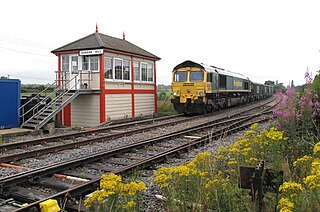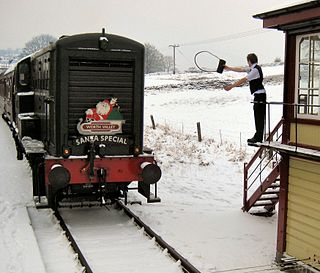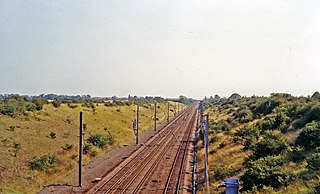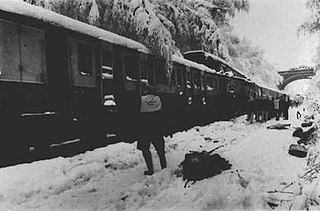
On a rail transport system, signalling control is the process by which control is exercised over train movements by way of railway signals and block systems to ensure that trains operate safely, over the correct route and to the proper timetable. Signalling control was originally exercised via a decentralised network of control points that were known by a variety of names including signal box, interlocking tower and signal cabin. Currently these decentralised systems are being consolidated into wide scale signalling centres or dispatch offices. Whatever the form, signalling control provides an interface between the human signal operator and the lineside signalling equipment. The technical apparatus used to control switches (points), signals and block systems is called interlocking.

Railway signalling (BE), also called railroad signaling (AE), is a system used to control the movement of railway traffic. Trains move on fixed rails, making them uniquely susceptible to collision. This susceptibility is exacerbated by the enormous weight and inertia of a train, which makes it difficult to quickly stop when encountering an obstacle. In the UK, the Regulation of Railways Act 1889 introduced a series of requirements on matters such as the implementation of interlocked block signalling and other safety measures as a direct result of the Armagh rail disaster in that year.

The Quintinshill rail disaster was a multi-train rail crash which occurred on 22 May 1915 outside the Quintinshill signal box near Gretna Green in Dumfriesshire, Scotland. It resulted in the deaths of over 200 people and remains the worst rail disaster in British history.

In railway signalling, a token is a physical object which a train driver is required to have or see before entering onto a particular section of single track. The token is clearly endorsed with the names of the section to which it belongs. A token system is more commonly used for single lines because of the greater risk of collision in the event of a mistake being made by a signaller or traincrew, than on double lines.
In data communications, flow control is the process of managing the rate of data transmission between two nodes to prevent a fast sender from overwhelming a slow receiver. Flow control should be distinguished from congestion control, which is used for controlling the flow of data when congestion has actually occurred. Flow control mechanisms can be classified by whether or not the receiving node sends feedback to the sending node.

The Abermule train collision was a head-on collision which occurred at Abermule, Montgomeryshire, Wales on Wednesday 26 January 1921, killing 17 people. The crash arose from misunderstandings between staff which effectively over-rode the safe operation of the Electric Train Tablet system protecting the single line. A train departed carrying the wrong tablet for the section it was entering and collided with a train coming the other way.

Kings Langley railway station is almost under the M25 motorway near Junction 20. It serves the village of Kings Langley, and the nearby villages of Abbots Langley and Hunton Bridge. The station is 21 miles (34 km) north west of London Euston on the West Coast Main Line. The station and all services calling at the station are operated by London Northwestern Railway.

Linienzugbeeinflussung is a cab signalling and train protection system used on selected German and Austrian railway lines as well as on the AVE and some commuter rail lines in Spain. The system was mandatory where trains were allowed to exceed speeds of 160 km/h (99 mph) in Germany and 220 km/h (140 mph) in Spain. It is also used on some slower railway and urban rapid transit lines to increase capacity. The German Linienzugbeeinflussung translates to continuous train control, literally: linear train influencing. It is also called linienförmige Zugbeeinflussung.

Absolute block signalling is a British signalling block system designed to ensure the safe operation of a railway by allowing only one train to occupy a defined section of track (block) at a time. Each block section is manually controlled by a signalman, who communicates with the other block sections via telegraph. This system was used on double or multiple lines where use of each line is assigned a direction of travel before the introduction of track circuits, and is still used on lines which lack track circuiting.
The Winwick rail crash took place at Winwick Junction, near Warrington on the London, Midland and Scottish Railway, on 28 September 1934. Two trains collided, resulting in 11 deaths and 19 injured.

The Clayton Tunnel rail crash occurred on Sunday 25 August 1861, five miles (8 km) from Brighton on the south coast of England. At the time it was the worst accident on the British railway system. A train ran into the back of another inside the tunnel, killing 23 and injuring 176 passengers.

Signalling block systems enable the safe and efficient operation of railways by preventing collisions between trains. The basic principle is that a track is broken up into a series of sections or "blocks". Only one train may occupy a block at a time, and the blocks are sized to allow a train to stop within them. That ensures that a train always has time to stop before getting dangerously close to another train on the same line. The block system is referred to in the UK as the method of working, in the US as the method of operation, and in Australia as safeworking.

The Abbots Ripton rail disaster occurred on 21 January 1876 at Abbots Ripton, then in the county of Huntingdonshire, England, on the Great Northern Railway main line, previously thought to be exemplary for railway safety. In the accident, the Special Scotch Express train from Edinburgh to London was involved in a collision, during a blizzard, with a coal train. An express travelling in the other direction then ran into the wreckage. The initial accident was caused by:

The Seer Green rail crash occurred on the morning of 11 December 1981 near Seer Green, Buckinghamshire, England between two four-car Class 115 diesel multiple units, killing one driver and three passengers.

A signalman or signaller is an employee of a railway transport network who operates the points and signals from a signal box in order to control the movement of trains.
Tyer's Electric Train Tablet system is a form of railway signalling for single line railways used in several countries; it was first devised in Great Britain by engineer Edward Tyer after the Thorpe rail accident of 1874, which left 21 people dead. It was used in New Zealand for close to 100 years until June 1994. The system used a hard disk called a tablet, a form of token.
The Battersea Park rail crash occurred on 2 April 1937, just south of Battersea Park railway station on the Southern Railway, in London, England. Two electrically driven passenger trains collided on the Up Local line; the second train, from Coulsdon North to Victoria, had been allowed into the section while it was still occupied by the first train, from London Bridge to Victoria. The signalman at Battersea Park, G. F. Childs, believing there was a fault with the Sykes electromechanical interlocking apparatus which was installed at the box, had opened up the case of the instrument and inadvertently cleared the interlock which should have prevented this situation. The official enquiry ruled that he subsequently accepted the Coulsdon train, although he should have been aware that the London Bridge train had not cleared the section. Ten people were killed, including the guard of the London Bridge train, and eighty people were injured, seven sustaining serious injuries. Another accident had occurred at Battersea Park in 1881.
The Kirtlebridge rail crash took place in 1872 at Kirtlebridge railway station in Dumfriesshire. An express passenger train ran into a goods train that was shunting; 11 people lost their lives immediately, and one further person succumbed later. The cause was a failure to communicate between the station master in charge of the shunting operation, and the signalman. There was not full interlocking of the points, and the block system of signalling was not in use.
In data networking, telecommunications, and computer buses, an acknowledgment (ACK) is a signal that is passed between communicating processes, computers, or devices to signify acknowledgment, or receipt of message, as part of a communications protocol. The negative-acknowledgement is a signal that is sent to reject a previously received message or to indicate some kind of error. Acknowledgments and negative acknowledgments inform a sender of the receiver's state so that it can adjust its own state accordingly.
The Welwyn Tunnel rail crash took place in Welwyn North Tunnel, north of Welwyn station on the Great Northern Railway, on 9 June 1866. According to L T C Rolt, "from the point of view of damage to engines and rolling stock it was one of the most destructive in railway history."











